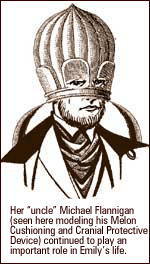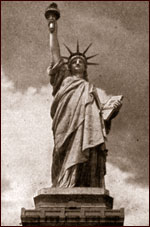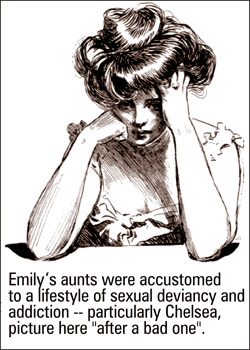 Writer, poet, social activist, explorer, aviatrix, and 92-year-old pole vaulter: Emily Chesley played many roles in her long and remarkable life. This week I am posting abridged excerpts from her biography, Get Bent: Emily Chesley’s Life of Speculation, which recounts the humble beginnings and formative experiences of the Speculative Songstress Of The Southwest. Chapter two (part two) of Emily’s bio here.
Writer, poet, social activist, explorer, aviatrix, and 92-year-old pole vaulter: Emily Chesley played many roles in her long and remarkable life. This week I am posting abridged excerpts from her biography, Get Bent: Emily Chesley’s Life of Speculation, which recounts the humble beginnings and formative experiences of the Speculative Songstress Of The Southwest. Chapter two (part two) of Emily’s bio here.
Flannigan’s inventive mind could not keep up with either the irrepressible debauchery of his sisters or Emily’s increasingly frequent counseling sessions with a sympathetic but expensive Dr. Abbie  FitzWeezepuddle. Near penniless, Michael had a new plan for his dysfunctional family. He’d heard about land being given away in the far western reaches of British North America and he dreamed of making a fresh start. “Surely,” he wrote in the opening entry of a diary dated October 13, 1869, “there must be some demand for locationists. I can only hope and pray.”
FitzWeezepuddle. Near penniless, Michael had a new plan for his dysfunctional family. He’d heard about land being given away in the far western reaches of British North America and he dreamed of making a fresh start. “Surely,” he wrote in the opening entry of a diary dated October 13, 1869, “there must be some demand for locationists. I can only hope and pray.”
Emily, bursting with the onset of womanhood, was thrilled with her trans-Atlantic accommodations in the third class hold of the S.S. Travesty. En route to America, she began her scientific schooling peppered by romantic between-deck encounters with a variety of Ians, Owens, Euans and Hamishes).
In so many ways, it was just like home, packed like sardines into their beds, nuzzling up against each other’s most pointy parts, and breathing the familiar fetid air of unwashed bodies. For Emily, reveling in both the emerging fire of her delicate years and the burgeoning sweep of her vivid imagination, it was revelatory. Her curvaceous buttocks squeezed surreptitiously by a passing young man named Sean (or was it Seamus?), she glowed within and without, and imagined beginning and ending each day with such pleasures. “Am I part of the throng, or am I simply wearing it?,” she wondered dreamily, brushing away the ardent and exploratory caresses of a youthful gentleman named Seamus (or was it Sean?).
Arriving at Ellis Island, in Lady Liberty’s fulsome shadow, [1] Emily suffered the indignity familiar to so many immigrants, as an official who had been imbibing too heavily of a crusty port over an extended luncheon changed her name, as if by rote. “Now you’re Irmgard Phlegmstein,” he decreed, as if such an edict could alter the inner essence of the vibrant young woman. It took several days, and liberal internal and external application of black coffee to persuade the besotted official of his error, but Irmgard was soon dismissed in favor of Emily. This bizarre event, though, was the beginning of a lifelong quest for identity that sent Emily and her familial entourage into the vast central plains of North America.
Leaving a broken-hearted trail of Ians, Owens, Euans and Hamishes in her wake, Emily found herself drawn to middle America, to the open skies and windswept expanses of North Dakota. There, in the midst of a sea of sugar beets and rich black soil, both Emily and Michael found themselves at
the center of their respective universes. He found the perfect spot to establish a focal point for his calling, encouraged by the insistence of the local expert in such matters as land and property that the key to success in a venture of this sort was “Locationism, locationism, locationism.” She, propelled down an entirely different path, found Norwegians.
They took the North Pacific Railroad to its terminus, and ended up in a small farming community near what is now Williston in the Dakota Territory. Fed a steady diet of science from Michael, Emily also continued to read her beloved mythology, delighting especially in the bleak world view of the Norse.
Perhaps it was this latter reading that left her in a frame of mind to throw herself at the un-named soldier who lived in the sod hut about two miles away.
It was a long toss, and unfortunately, the Norwegian was unable to catch it due to a “sexually indescribable fencing wedgie”. Emily was outraged and jilted him in a scene of such humiliation, his name has never been mentioned since. Meanwhile Michael Flannigan continued to work on his inventions. The most successful of which was the women’s undergarment of the future: the Thong. Emily thoroughly endorsed the product and was more than willing to show off its many benefits. Thus it came to be that the Thors, Ivors and Bjorns of the community came to lie broken and panting in the wake of her merchandising frenzy. The town fathers and church leaders, upright in their support of Emily’s youthful exuberance, were cowardly in the end, and did not object when the womenfolk demanded that the community expel the family.
Next time: The Wilderness Years
Notes:
 1. Scholars are divided on when Emily and her family actually arrived in North America. Whether the event occurred in 1869 or 1870, however, one could only arrive in at Ellis Island, under “Lady Liberty’s fulsome shadow”, after 1884. Also, Ellis Island was not in use until the 1890s. However it is true that nearby on the deck of the Travesty was one Libby Learty, a butcher’s wife from Galway whose six-foot 300-pound frame was said to cast quite a fulsome shadow. This too could be a source of scholarly confusion over accounts of Emily’s arrival in New York City.
1. Scholars are divided on when Emily and her family actually arrived in North America. Whether the event occurred in 1869 or 1870, however, one could only arrive in at Ellis Island, under “Lady Liberty’s fulsome shadow”, after 1884. Also, Ellis Island was not in use until the 1890s. However it is true that nearby on the deck of the Travesty was one Libby Learty, a butcher’s wife from Galway whose six-foot 300-pound frame was said to cast quite a fulsome shadow. This too could be a source of scholarly confusion over accounts of Emily’s arrival in New York City.
It can only be said that the exact dates of several events in Emily’s life between 1869 and her arrival in London, Canada, in 1880 are, at best, murky.
 Friar Parsnip was also the master of the region’s only school, which met every morning after mass for two hours in the 13th century Ennis Friary. It was there that Emily learned to read and love speculative fiction. [3] But while not immersed in the fairy tales told by the Friar or sitting in her uncle’s laboratory while he tinkered, Emily was an unhappy child. Emily was prone at a very early age to outbursts,” as Molly called them; expressed through a twisted combination of violence and creativity, they quite often involved small animals and vaguely satanic rituals. Friar Parsnip tried to control the child, through blandishments of Mary’s love, and warnings that she would drink hellfire. Emily thought of these bribes and threats as mere story telling, and would pat the good-natured Friar on the cheek while she smeared lark’s vomit on the neighbor’s poodle, Yumyum.
Friar Parsnip was also the master of the region’s only school, which met every morning after mass for two hours in the 13th century Ennis Friary. It was there that Emily learned to read and love speculative fiction. [3] But while not immersed in the fairy tales told by the Friar or sitting in her uncle’s laboratory while he tinkered, Emily was an unhappy child. Emily was prone at a very early age to outbursts,” as Molly called them; expressed through a twisted combination of violence and creativity, they quite often involved small animals and vaguely satanic rituals. Friar Parsnip tried to control the child, through blandishments of Mary’s love, and warnings that she would drink hellfire. Emily thought of these bribes and threats as mere story telling, and would pat the good-natured Friar on the cheek while she smeared lark’s vomit on the neighbor’s poodle, Yumyum. nouveau riche of Westminster. In fact, the “party brat” (by which the device was affectionately known) became so ubiquitous that it was considered one of the primary factors responsible for a dramatic increase in cannabis use witnessed throughout Ireland during the late 1850s and early 1860s. [1]
nouveau riche of Westminster. In fact, the “party brat” (by which the device was affectionately known) became so ubiquitous that it was considered one of the primary factors responsible for a dramatic increase in cannabis use witnessed throughout Ireland during the late 1850s and early 1860s. [1] Prostitution was rampant in 1850s London and the spirochete treponema was having a class-blind field day. Flannigan’s Phanerogam Rendering Tube was the answer to every English gent’s problem with syphilis. [3]
Prostitution was rampant in 1850s London and the spirochete treponema was having a class-blind field day. Flannigan’s Phanerogam Rendering Tube was the answer to every English gent’s problem with syphilis. [3] Napoleon surrenders to the English, July 15, 1815
Napoleon surrenders to the English, July 15, 1815